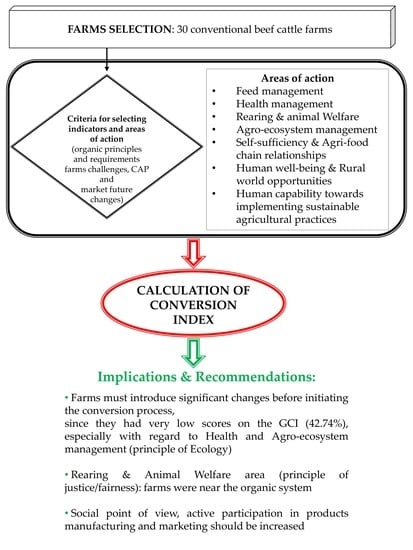Beef Cattle Farms’ Conversion to the Organic System. Recommendations for Success in the Face of Future Changes in a Global Context
Abstract
:1. Introduction
2. Materials and Methods
2.1. Study Area
2.2. Farms Selection
Sample Characterization: Conventional Farms
2.3. Selection of Indicators
2.4. Ordination of Indicators in Areas of Action, Allocation of Optimal Values and Relative Weights
2.5. Calculation of Conversion Index: Individual Conversion Scores, Partial Conversion Index (PCI) and Global Conversion Index (GCI)
- (1)
- When the indicators have an optimum value corresponding to either the maximum value of the sample or the value 1 for the case of qualitative variables, the scores were calculated as follows (Equation (1)):Individual conversion score = (initial value of the indicator/optimal value) × 100
- (2)
- However, for indicators whose optimal value was the minimum value found in the sample (i.e., distance traveled by feed), the scores were calculated as follows (Equation (2)):Individual conversion score = (optimal value/initial value of the indicator) × 100
- (3)
- When optimum values were percentiles (range of values) or recommended values (such as farmer’s age), the formula applied depended upon the magnitude of the indicator values and their optimal value. If the value of the indicator was lower than the optimum value, the Equation (1) was applied. In contrast, when the indicator value was higher than the optimal value, Equation (2) was applied. Moreover, for certain indicators, more details must be taken into account. Thus, in cases such as that of total stocking rate, either exceeding or not reaching the optimal value penalized the farm, since both high and low values lead to ecosystem degradation. In other variables (i.e., self-sufficiency), the value of individual conversion scores remained 100% although the indicator value is greater than the optimum value. This allows for conversion rates for each indicator as the production systems are studied.
2.6. Statistical Analysis of Results
3. Results
Farms’ Typologies: PCI and GCI Scores
4. Discussion
4.1. Feed Management
4.2. Health Management
4.3. Rearing and Animal Welfare
4.4. Agro-Ecosystem Management
4.5. Self-Sufficiency and Agri-Food Chain Relationships
4.6. Human Well-Being and Rural World Opportunities
4.7. Human Capability towards Implementing Sustainable Agricultural Practices
4.8. Other Aspects Worthy of Discussion: Barriers, Perspectives and Solutions
5. Conclusions
Acknowledgments
Conflicts of Interest
References
- Magrama 2015. Ministerio de Agricultura, Alimentación y Medio Ambiente. Agricultura Ecológica. Estadísticas 2014. Available online: http://www.magrama.gob.es/es/alimentacion/temas/la-agricultura-ecologica/estadisticas_ae_2014_definitivopdf_tcm7-405122.pdf (accessed on 14 March 2016).
- Nardone, A.; Zervas, G.; Ronchi, B. Sustainability of small ruminant organic systems of production. Livest. Prod. Sci. 2004, 90, 27–39. [Google Scholar] [CrossRef]
- Escribano, A.J. Organic livestock farming: Challenges, perspectives, and strategies to increase its contribution to the agrifood system’s sustainability. In Organic Farming—A Promising Way of Food Production, 1st ed.; Konvalina, P., Ed.; InTech: Rijeka, Croatia, 2016; pp. 229–260. [Google Scholar]
- Benoit, M.; Veysset, P. Conversion of cattle and sheep suckler farming to organic farming: Adaptation of the farming system and its economic consequences. Livest. Prod. Sci. 2003, 80, 141–152. [Google Scholar] [CrossRef]
- Blanco-Penedo, I.; López-Alonso, M.; Shore, R.F.; Miranda, M.; Castillo, C.; Hernández, J.; Benedito, J.L. Evaluation of organic, conventional and intensive beef farm systems: Health, management and animal production. Animal 2012, 6, 1503–1511. [Google Scholar] [CrossRef] [PubMed]
- European Commission. EEC Council Directive 92/43/EEC of 21 May 1992 on the Conservation of Natural Habitats and of Wild Fauna and Flora. 1992. Available online: http://ec.europa.eu/environment/nature/legislation/habitatsdirective/index_en.htm (accessed on 14 March 2016).
- Moreno, G.; Pulido, F.J. The functioning, management and persistence of Dehesas. In Agroforestry in Europe: Current Status and Future Prospects, 1st ed.; Rigueiro-Rodríguez, A., McAdam, J., Mosquera-Losado, M., Eds.; Springer Science + Business Media B.V.: Dordrecht, The Netherlands, 2009; pp. 127–160. [Google Scholar]
- Sánchez, J. Las macromagnitudes agrarias. In La Agricultura y la Ganadería Extremeñas. Informe 2012; Facultad de Ciencias Económicas y Empresariales/Escuela de Ingenierías Agrarias, Universidad de Extremadura, Caja de Badajoz: Badajoz, Spain, 2013; pp. 37–52. [Google Scholar]
- Easdale, M.H.; Aguiar, M.R. Regional forage production assessment in arid and semi-arid rangelands—A step towards social-ecological analysis. J. Arid Environ. 2012, 83, 35–44. [Google Scholar] [CrossRef]
- Peacock, C.; Sherman, D.M. Sustainable goat production—Some global perspectives. Small Rumin. Res. 2010, 89, 70–80. [Google Scholar] [CrossRef]
- Prudencio, C. El mercado de trabajo. In La Agricultura y Ganadería Extremeña. Informe 2012; Facultad de Ciencias Económicas y Empresariales/Escuela de Ingenierías Agrarias, Universidad de Extremadura, Caja de Badajoz: Badajoz, Spain, 2013; pp. 266–270. [Google Scholar]
- Marsden, T.; Banks, J.; Bristow, G. The social management of rural nature: Understanding agrarian-based rural development. Environ. Plan. A 2002, 34, 809–825. [Google Scholar] [CrossRef]
- Pretty, J. Agriculture: Reconnecting People, Land and Nature; Earthscan: London, UK, 2002; p. 261. [Google Scholar]
- Boyazoglu, J.; Hatziminaoglou, I.; Morand-Fehr, P. The role of the goat in society: Past, present and perspectives for the future. Small Rumin. Res. 2005, 60, 13–23. [Google Scholar] [CrossRef]
- De Rancourt, M.; Fois, N.; Lavín, M.P.; Tchakérian, E.; Vallerand, F. Mediterranean sheep and goats production: An uncertain future. Small Rumin. Res. 2006, 62, 167–179. [Google Scholar] [CrossRef]
- Cocca, G.; Sturaro, E.; Gallo, L.; Ramanzin, M. Is the abandonment of traditional livestock farming systems the main driver of mountain landscape change in Alpine areas? Land Use Pol. 2012, 29, 878–886. [Google Scholar] [CrossRef]
- MacDonald, D.; Crabtree, J.R.; Wiesinger, G.; Dax, T.; Stamou, N.; Fleury, P.; Lazpita, J.G.; Gibon, A. Agricultural abandonment in mountain areas of Europe: Environmental consequences and policy response. J. Environ. Manag. 2000, 59, 47–69. [Google Scholar] [CrossRef]
- Gellrich, M.; Baur, P.; Koch, B.; Zimmermann, N.E. Agricultural land abandonment and natural forest re-growth in the Swiss mountain: A spatially explicit economic analysis. Agric. Ecosyst. Environ. 2007, 118, 93–108. [Google Scholar] [CrossRef]
- Gaspar, P.; Mesías, F.J.; Escribano, M.; Pulido, F. Sustainability in Spanish extensive farms (Dehesas): An economic and management indicator-based evaluation. Rangel. Ecol. Manag. 2009, 62, 153–162. [Google Scholar] [CrossRef]
- Franco, J.A.; Gaspar, P.; Mesías, F.J. Economic analysis of scenarios for the sustainability of extensive livestock farming in Spain under the CAP. Ecol. Econ. 2012, 74, 120–129. [Google Scholar] [CrossRef]
- Escribano, A.J.; Gaspar, P.; Mesias, F.J.; Pulido, A.F.; Escribano, M. A sustainability assessment of organic and conventional beef cattle farms in agroforestry systems: The case of the Dehesa rangelands. ITEA 2014, 110, 343–367. [Google Scholar] [CrossRef]
- Mena, Y.; Nahed, J.; Ruiz, F.A.; Sánchez-Muñoz, J.B.; Ruiz-Rojas, J.L.; Castel, J.M. Evaluating mountain goat dairy systems for conversion to the organic model, using a multicriteria method. Animal 2012, 6, 693–703. [Google Scholar] [CrossRef] [PubMed]
- Toro-Mújica, P.; García, A.; Gómez-Castro, A.G.; Acero, R.; Perea, J.; Rodríguez-Estévez, V.; Aguilar, C.; Vera, R. Technical efficiency and viability of organic dairy sheep farming systems in a traditional area for sheep production in Spain. Small Rumin. Res. 2011, 100, 89–95. [Google Scholar] [CrossRef]
- Toro-Mújica, P.; García, A.; Gómez-Castro, A.; Perea, J.; Rodríguez-Estévez, V.; Angón, E.; Barba, C. Organic dairy sheep farms in south-central Spain: Typologies according to livestock management and economic variables. Small Rumin. Res. 2012, 104, 28–36. [Google Scholar] [CrossRef]
- Escribano, A.J.; Gaspar, P.; Mesías, F.J.; Escribano, M.; Pulido, F. Comparative sustainability assessment of extensive beef cattle farms in a high nature value agroforestry system. In Rangeland Ecology, Management and Conservation Benefits, 1st ed.; Squires, V.R., Ed.; Nova Publishers: New York, NY, USA, 2015; pp. 65–85. [Google Scholar]
- IFOAM. Principles of Organic Agriculture. International Federation of Organic Agriculture Movements, 2005. Available online: http://www.ifoam.org/en/organic-landmarks/principles-organic-agriculture (accessed on 22 January 2016).
- The Council of the European Union. Council Regulation (EC) No. 834/2007 of 28 June 2007 on organic production and labelling of organic products and repealing Regulation (ECC) No. 2092/91. Off. J. Eur. Union 2007, 50, 1–23. [Google Scholar]
- Mena, Y.; Nahed, J.; Ruiz, F.A.; Castel, J.M.; Ligero, M. Proximity to the organic model of dairy goat systems in the Andalusian Mountains (Spain). Trop. Subtrop. Agroecosyst. 2009, 11, 69–73. [Google Scholar]
- Nahed-Toral, J.; Sanchez-Munoz, B.; Mena, Y.; Ruiz-Rojas, J.; Aguilar-Jimenez, R.; Castel, J.M.; de Asis Ruiz, F.; Orantes-Zebadua, M.; Manzur-Cruz, A.; Cruz-Lopez, J.; et al. Potential for conversion of agrosilvopastoral systems of dairy cattle to the organic production model in southern eastern Mexico. J. Anim. Vet. Adv. 2012, 11, 3081–3093. [Google Scholar] [CrossRef]
- Nahed-Toral, J.; Sánchez-Muñoz, B.; Mena, Y.; Ruiz-Rojas, J.; Aguilar-Jimenez, R.; Castel, J.M.; de Asis Ruiz, F.; Orantes-Zebadua, M.; Manzur-Cruz, A.; Cruz-López, J.; et al. Feasibility of converting agrosilvopastoral systems of dairy cattle to the organic production model in south eastern Mexico. J. Clean. Prod. 2013, 43, 136–145. [Google Scholar] [CrossRef]
- Boatto, V.; Trestini, S. The role of post-2013 common agricultural policy on the sustainability of Italian beef production. Agric. Conspec. Sci. 2013, 78, 137–141. [Google Scholar]
- The European Parliament and the Council of the European Union. Regulation (EU) No 1306/2013 of the European Parliament and of the Council of 17 December 2013 on the Financing, Management and Monitoring of the Common Agricultural Policy and Repealing Council Regulations (EEC) No 352/78, (EC) No 165/94, (EC) No 2799/98, (EC) No 814/2000, (EC) No 1290/2005 and (EC) No 485/2008. Available online: http://eur-lex.europa.eu/legal-content/EN/ALL/?uri=celex:32013R1306 (accessed on 16 June 2016).
- Wittman, H.; Becky, M.; Hergesheimer, C. Linking local food systems and the social economy? Future roles for farmers’ markets in Alberta and British Columbia. Rural Soc. 2012, 77, 36–61. [Google Scholar] [CrossRef]
- Leach, T.; Baret, P.V.; Stilmant, D. Sustainability indicators for livestock farming. A review. Agron. Sustain. Dev. 2013, 33, 311–327. [Google Scholar] [CrossRef]
- Nahed, J.; Castel, J.M.; Mena, Y.; Caravaca, F. Appraisal of the sustainability of dairy goat systems in Southern Spain according to their degree of intensification. Livest. Sci. 2006, 101, 10–23. [Google Scholar] [CrossRef]
- Ripoll-Bosch, R.; Díez-Unquera, B.; Ruiz, R.; Villalba, D.; Molina, E.; Joy, M.; Olaizola, A.; Bernués, A. An integrated sustainability assessment of Mediterranean sheep farms with different degrees of intensification. Agric. Syst. 2012, 105, 46–56. [Google Scholar] [CrossRef]
- Kerselaers, E.; Cock, L.D.; Lauwers, L.; Huylenbroeck, G.V. Modelling farm-level economic potential for conversion to organic farming. Agric. Syst. 2007, 94, 671–682. [Google Scholar] [CrossRef]
- Masera, O.; Astier, S.; López-Ridaura, S. Sustentabilidad y manejo de los recursos naturales. In El Marco de Evaluación MESMIS, 1st ed.; Masera, O., Astier, S., López-Ridaura, S., Eds.; Mundi-Prensa, IE-UNAM: Mexico, 1999; p. 160. [Google Scholar]
- Ten Brink, B.J.E.; Hosper, S.H.; Colin, F. A quantitative method for description and assessment of ecosystems: The AMOEBA approach. Mar. Pollut. Bull. 1991, 23, 265–270. [Google Scholar] [CrossRef]
- Astier, M.; García-Barrios, L.; Galván-Miyoshi, Y.; González-Esquivel, C.E.; Masera, O.R. Assessing the Sustainability of Small Farmer Natural Resource Management Systems. A Critical Analysis of the MESMIS Program (1995–2010). Ecol. Soc. 2012, 17, 25. [Google Scholar] [CrossRef]
- Hair, J.F.; Anderson, R.F.; Tathakm, R.L.; Black, W.C. Análisis Multivariante, 5th ed.; Hair, J.F., Anderson, R.E., Tatham, R.L., Eds.; Prentice Hall Iberia: Madrid, Spain, 1999; p. 832. [Google Scholar]
- SPSS (Statistical Package for the Social Sciences). Manual del Usuario del Sistema Básico de IBM SPSS Statistics 21; IBM Corporation: Armonk, NY, USA, 2012; p. 464. [Google Scholar]
- Ripoll-Bosch, R.; Joy, M.; Bernués, A. Role of self-sufficiency, productivity and diversification on the economic sustainability of farming systems with autochthonous sheep breeds in less favoured areas. Animal 2013, 4, 1–9. [Google Scholar] [CrossRef] [PubMed]
- The Commission of the European Communities. Commission Regulation (EC) No. 889/2008 Laying down Detailed Rules for the Implementation of Commission Regulation (EC) No. 834/2007 on Organic Production and Labelling of Organic Products with Regard to Organic Production, Labelling and Control. Available online: http://eur-lex.europa.eu/LexUriServ/LexUriServ.do?uri=OJ:L:2008:250:0001:0084:en:PDF (accessed on 16 June 2016).
- Dantsis, T.; Loumou, A.; Giourga, C. Organic agriculture’s approach towards sustainability; its relationships with the agro-industrial complex, a case study in Central Macedonia, Greece. J. Agric. Environ. Ethics 2009, 22, 197–216. [Google Scholar] [CrossRef]
- Andriarimalala, J.H.; Rakotozandriny, J.N.; Andriamandroso, A.L.H.; Penot, E.; Naudin, K.; Dugué, P.; Tillard, E.; Decruyenaere, V.; Salgado, P. Creating synergies between conservation agriculture and cattle production in crop-livestock farms: A study case in the lake Alaotra region of Madagascar. Exp. Agric. 2013, 49, 352–365. [Google Scholar] [CrossRef]
- Sanderson, M.A.; Archer, D.; Hendrickson, J.; Kronberg, S.; Liebig, M.; Nichols, K.; Schmer, M.; Tanaka, D.; Aguilar, J. Diversification and ecosystem services for conservation agriculture: Outcomes from pastures and integrated crop-livestock systems. Renew. Agric. Food Syst. 2013, 28, 129–144. [Google Scholar] [CrossRef]
- Hrabalová, A.; Zander, K. Organic beef farming in the Czech Republic: Structure, development and economic performance. Agric. Econ. Czech 2006, 52, 89–100. [Google Scholar]
- Tzouramani, I.; Sintori, A.; Liontakis, A.; Karanikolas, P.; Alexopoulos, G. An assessment of the economic performance of organic dairy sheep farming in Greece. Livest. Sci. 2011, 141, 136–142. [Google Scholar] [CrossRef]
- Argyropoulos, C.; Tsiafouli, M.A.; Sgardelis, S.P.; Pantis, J.D. Organic farming without organic products. Land Use Pol. 2013, 32, 324–328. [Google Scholar] [CrossRef]
- The World of Organic Agriculture. Statistics & Emerging Trends; FIBL & IFOAM: Rheinbreitbach, Switzerland, 2016; p. 333. Available online: https://shop.fibl.org/fileadmin/documents/shop/1698-organic-world-2016.pdf (accessed on 16 June 2016).
- Lobley, M.; Butler, A.; Reed, M. The contribution of organic farming to rural development: An exploration of the socio-economic linkages of organic and non-organic farms in England. Land Use Pol. 2009, 26, 723–735. [Google Scholar] [CrossRef]
- García-Torres, S.; López-Gajardo, A.; Mesías, F.J. Intensive vs. free-range organic beef. A preference study through consumer liking and conjoint analysis. Meat Sci. 2016, 114, 114–120. [Google Scholar] [CrossRef]
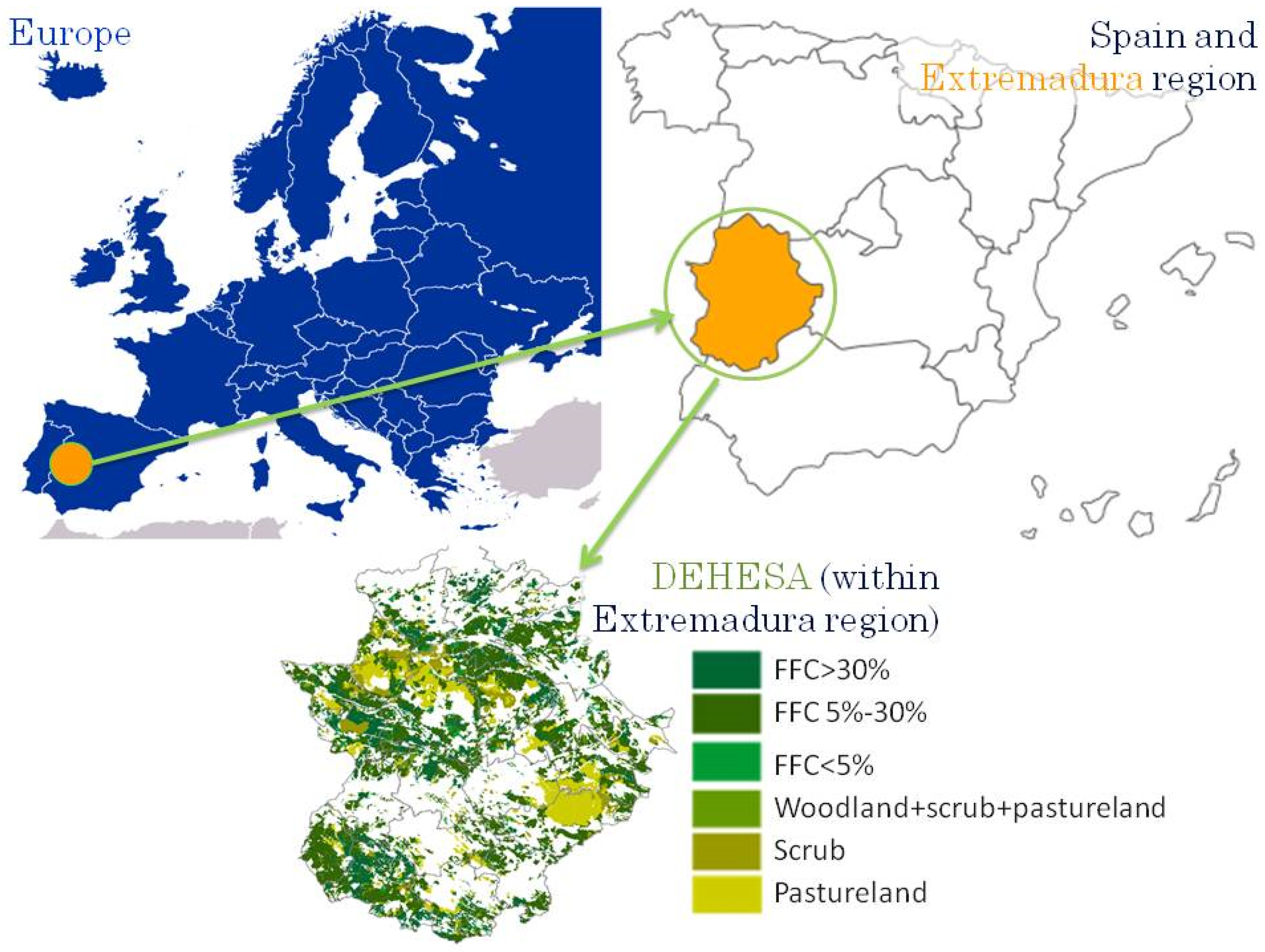
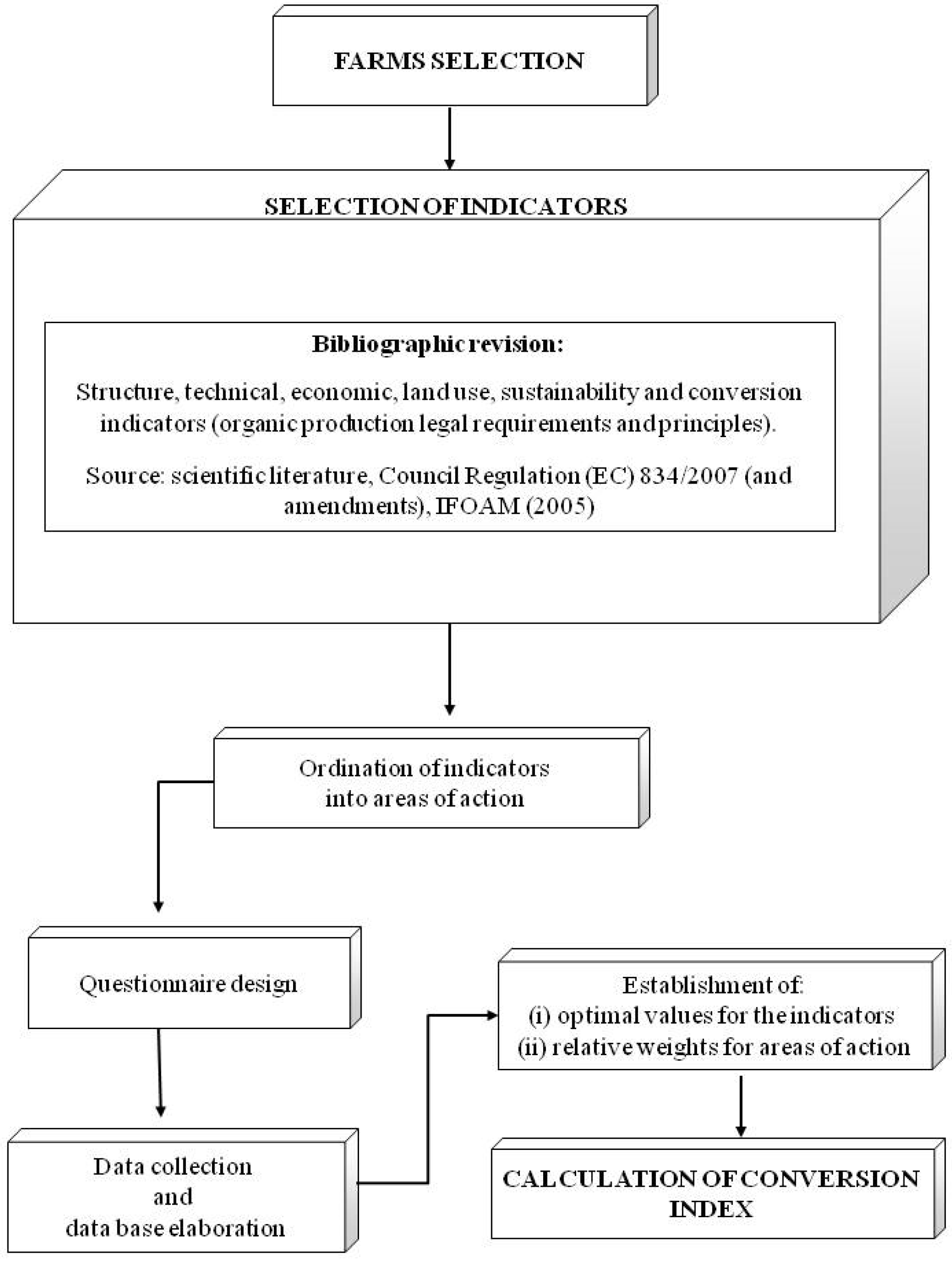

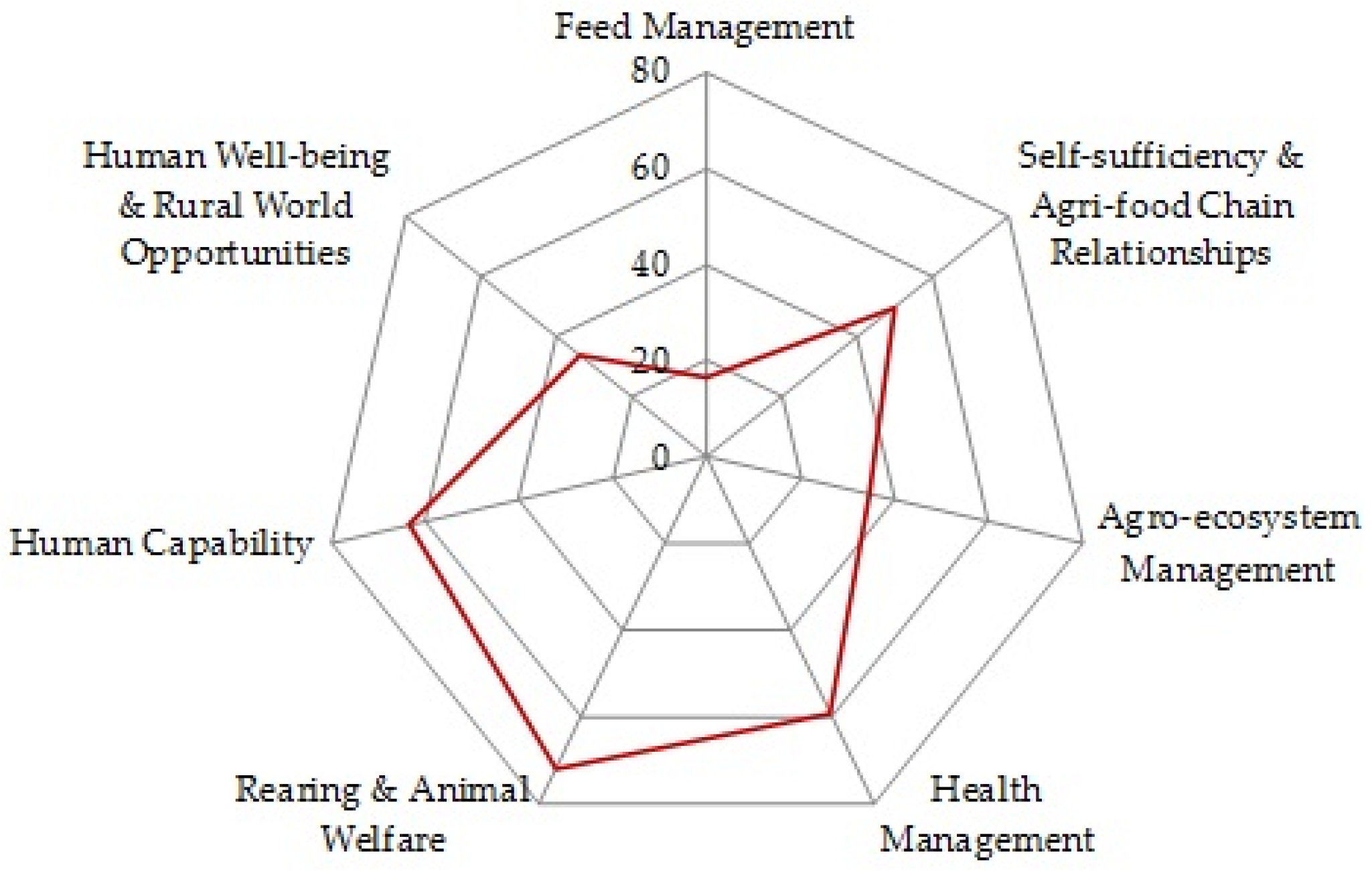
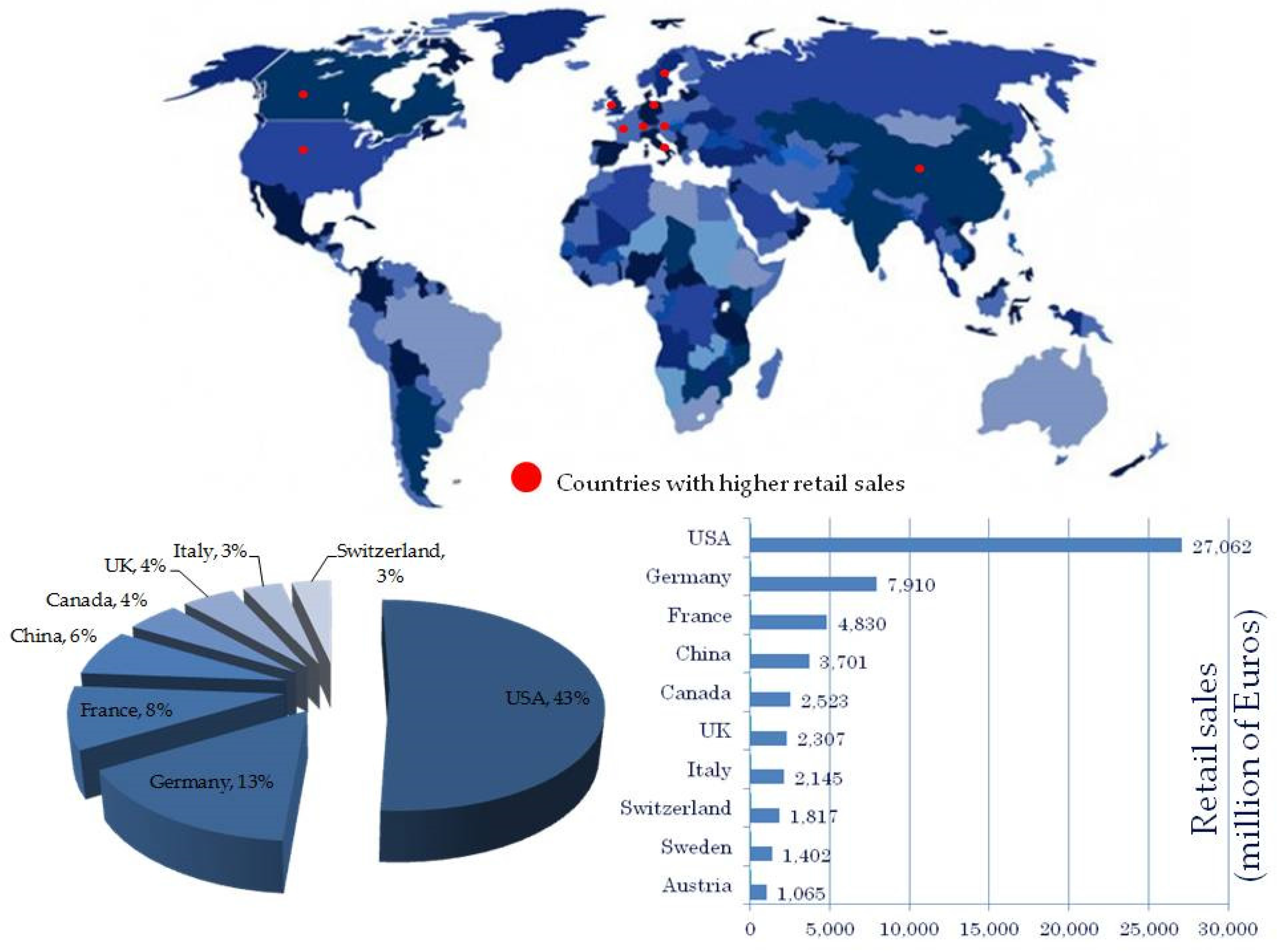
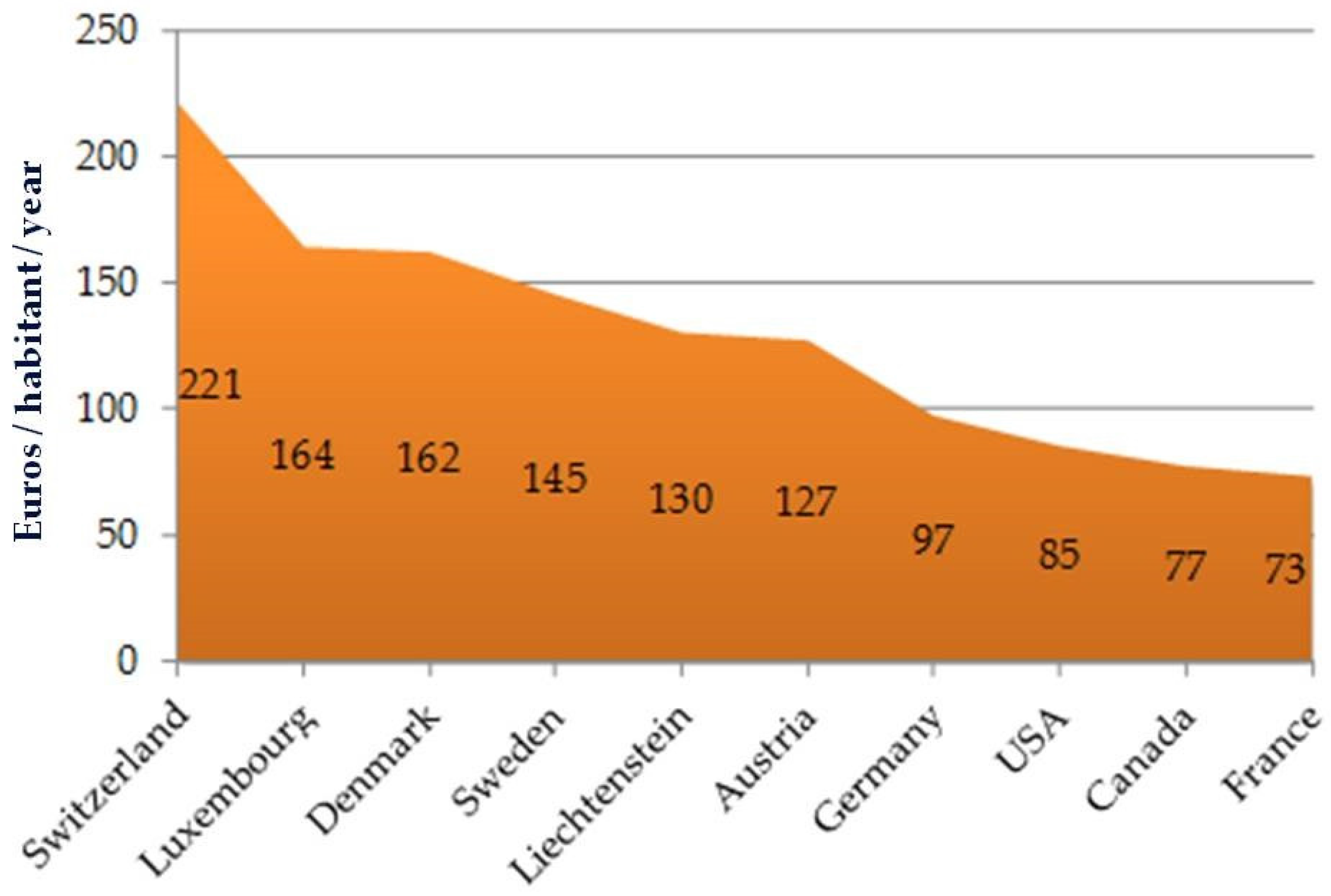
| Conversion Indicators and Areas of Action | Definitions and Units | Dummy | Optimal Value | Criteria 1 | Principle 2 | Weight (%) |
|---|---|---|---|---|---|---|
| Organic concentrate to fattening calves | Fattening calves were given organic concentrates. | Yes | 1 | Comp. | ||
| Organic fodder to fattening calves | Fattening calves were given organic fodder/grass. | Yes | 1 | Comp. | ||
| Organic concentrate to adults | Cows and bulls were given organic concentrates. | Yes | 1 | Comp. | ||
| Organic fodder to adults | Cows and bulls were given organic fodder/grass. | Yes | 1 | Comp. | ||
| Ration 60:40 | At least 60% of daily ration was based on common forage and/or grass. | Yes | 1 | Comp. | ||
| Feed management | 1, 2 | 21.68 | ||||
| Number of veterinary medicines to calves | Calves (younger than one year) do not receive more than 1 treatment. | Yes | 1 | Comp. | ||
| Number of veterinary medicines to adults | Adults neither receive more than 3 veterinary medicines nor 2 antiparasitics per year. | Yes | 1 | Comp. | ||
| Preventive antiparasitics | The farmer did not use antiparasitics systematically as a preventive health management practice. | Yes | 1 | Comp. | ||
| Preventive antibiotics | The farmer did not use antibiotics systematically as a preventive health management practice. | Yes | 1 | Comp. | ||
| Healthy herd | The herd was healthy. | Yes | 1 | Comp. | ||
| Cleaning products | Products used to clean the infrastructure were allowed by the Council Regulation. | Yes | 1 | Comp. | ||
| Isolating for health reasons | Livestock was isolated when they were suffering infectious diseases easily contagious. | Yes | 1 | Comp. | ||
| Quarantine | Livestock were isolated when coming from other farms. | Yes | 1 | Comp. | ||
| Alternative medicine | The farmer used phytotherapy and/or homeopathy. | Yes | 1 | Comp. | ||
| Water quality assessment | Water quality was assessed at least annually. | Yes | 1 | Comp. | ||
| Vaccines | The farmer did not use of vaccines for non-endemic illnesses. | Yes | 1 | Comp. | ||
| Health Management | 1, 3, 2 | 20.83 | ||||
| Calves access to open spaces | Calves have permanent access to open spaces. | Yes | 1 | Comp. | ||
| Adults access to open spaces | Adults have permanent access to open spaces. | Yes | 1 | Comp. | ||
| Infrastructure (meters and facilities) | The infrastructure was adequate with regard to the meters and facilities needed for organic beef farms. | Yes | 1 | Comp. | ||
| Calving period | The calving period was adequately organized in order to make better use of the available natural resources. | Yes | 1 | Comp. | ||
| Infrastructure (cleanness) | The infrastructure was adequate with regard to cleanness. | Yes | 1 | Comp. | ||
| Fattening period length | It was less than 3 months and less than 1/5 of their lifespan. | Yes | 1 | Comp. | ||
| Protection against bad weather | The infrastructure has protection against sunlight, heat, raining, etc. | Yes | 1 | Comp. | ||
| Weaning age | The lactation period lasted at least 3 months. | Yes | 1 | Comp. | ||
| Isolating/Tying | Livestock was not isolated and/or tied up for reasons that were not related to health management. | Yes | 1 | Comp. | ||
| Mutilations | The farmer does not carry out mutilations. | Yes | 1 | Comp. | ||
| Autochthonous bovine breeds | 75% or more of the cattle was autochthonous or considered as such in the region under study. | Yes | 1 | Comp. | ||
| Animal welfare training | The farmer has attended to animal welfare courses. | Yes | 1 | Comp. | ||
| Rearing and Animal Welfare | 4, 1 | 9.17 | ||||
| Stocking rate | Livestock Units/ha. | No | 0.33–0.5 | Rec. | ||
| Use of pesticides and/or herbicides | The farmer did not use pesticides and/or herbicides. | Yes | 1 | Comp. | ||
| Use of mineral fertilizers | The farmer did not use mineral fertilizers. | Yes | 1 | Comp. | ||
| Rotational grazing | Grazing was organized so that all plots were not grazed continuously. | Yes | 1 | Comp. | ||
| % of wooded area | Wooded area/total area. | No | 1.00 | Max. | ||
| Dung management | Qualitative scale (0–3). 0: There was no dung accumulation due to extensification; 1: No heaping, then spreading of immature dung; 2: There was some heaping (not enough), so that dung was not spread completely mature; 3: Proper compost elaboration, and spreading. | No | 0 and 3 | Rec. | ||
| Legumes | Dichotomic. O: No. 1: Yes. Legumes were planted in isolation or associated with grains. | Yes | 1 | Max. | ||
| Reforestation | Dichotomic. O: No. 1: Yes. The farmer plant autochthonous trees. | Yes | 1 | Max. | ||
| Reduced tillage | Dichotomic. O: No. 1: Yes. Reduced or no-tillage agriculture was practiced. | Yes | 1 | Max. | ||
| Crop rotation | Dichotomic. O: No. 1: Yes. The farmer practices fallow, crop rotation, etc. | Yes | 1 | Max. | ||
| Crop association/Intercropping | Dichotomic. O: No. 1: Yes. The farmer practices crop associations/intercropping. | Yes | 1 | Max. | ||
| Cover crops | Dichotomic. O: No. 1: Yes. The farmer used cover crops. | Yes | 1 | Max. | ||
| Agro-Ecosystem Management | 2, 1, 3 | 19.83 | ||||
| Self-sufficiency | % Mkcal of feed obtained from the = (1 − MKcal of external feedstuff)/nutritional requirements. | No | 99.06 | Max. | ||
| Direct sales | Dichotomic. O: No. 1: Yes. Farmers sold products directly to consumers. | Yes | 1 | Max. | ||
| Distance to the slaughterhouse | Km to the nearest slaughterhouses (organically certified ones in the case of organic farms). | No | 12.48 | Min. | ||
| Elaboration of products | Dichotomic. O: No. 1: Yes. The farmer add value to the carcass/meat: packaging, etc. | Yes | 1 | Max. | ||
| Km travelled by the fodder | Mean distance (km) to the market place. | No | 0.00 | Max. | ||
| Self-Sufficiency and Agri-Food Chain Relationships | 4, 2 | 15.33 | ||||
| Business diversification | Number of agricultural activities and products. | No | 3 | Max. | ||
| Job creation potential | Total AWU 3/100 ha UAA 4 (AWU/100 ha). | No | 1.37 | C3 | ||
| Workforce stability | (Fixed AWUs/Salaried AWUs ) × 100 ha. | No | 0.01 | C3 | ||
| Satisfaction level | Qualitative scale (0–3). Increasing level of satisfaction level. | No | 3 | Max. | ||
| Labor attractiveness of the farm | Number of External workers (AWU/100 ha). | No | 0.67 | C3 | ||
| Human Well-Being and Rural World Opportunities | 4 | 8.83 | ||||
| Agroecology training | Farmer attended agroecology/organic production courses/seminars Dichotomic. O: No. 1: Yes. The farmer has been trained in agroecology. | Yes | 1 | Max. | ||
| Level of studies | Qualitative scale (1–3). 1: No studies or basic educational level; 2: High school or and/or vocational education and training; 3: University degree or higher. | No | 1 | Max. | ||
| Farmer’ age | Years. | No | 30 | Rec. | ||
| Data registering | Dichotomic. O: No. 1: Yes. Farmer records technical and economic data. | Yes | 1 | Max. | ||
| Continuity/Future plans | Qualitative scale (1–4).1: Abandon; 2: Herd reduction or change of species; 3: Maintain specie(s) reared and herd size; 4: Increase the herd size. | No | 3 and 4 | Max. | ||
| Human Capability Towards Implementing Sustainable Agricultural Practices | 4 | 4.33 | ||||
| Areas of Action | Indicators | Sample Mean (%) | SE |
|---|---|---|---|
| Feed Management | Organic concentrate to fattening calves | 00.00 | 00.00 |
| Organic fodder to fattening calves | 00.00 | 00.00 | |
| Organic concentrate to adults | 00.00 | 00.00 | |
| Organic fodder to adults | 00.00 | 00.00 | |
| Ration 60:40 | 83.33 | 6.92 | |
| Health Management | Number of veterinary medicines to calves | 90.00 | 5.57 |
| Number of veterinary medicines to adults | 93.33 | 4.63 | |
| Preventive antiparasitics | 3.33 | 3.33 | |
| Preventive antibiotics | 73.33 | 8.21 | |
| Healthy herd | 100.00 | 0.00 | |
| Cleaning products | 20.00 | 7.43 | |
| Isolating for health reasons | 90.00 | 5.57 | |
| Quarantine | 46.67 | 9.26 | |
| Alternative medicine | 0.00 | 0.00 | |
| Water quality assessment | 33.33 | 8.75 | |
| Vaccines | 100.00 | 0.00 | |
| Rearing and Animal Welfare | Calves access to open spaces | 100.00 | 0.00 |
| Adults access to open spaces | 100.00 | 0.00 | |
| Infrastructure (meters and facilities) | 0.00 | 0.00 | |
| Calving period | 33.33 | 8.75 | |
| Infrastructure (cleanness) | 100.00 | 0.00 | |
| Fattening period length | 83.33 | 6.92 | |
| Protection against bad weather | 43.33 | 9.20 | |
| Weaning age | 96.67 | 3.33 | |
| Isolating/Tying | 100.00 | 0.00 | |
| Mutilations | 100.00 | 0.00 | |
| Autochthonous bovine breeds | 13.33 | 6.31 | |
| Animal welfare training | 93.33 | 4.63 |
| Area of Action | Indicators | Sample Mean (%) | SE |
|---|---|---|---|
| Agro-Ecosystem Management | Stocking rate | 61.47 | 4.60 |
| Use of pesticides and/or herbicides | 73.33 | 8.21 | |
| Use of mineral fertilizers | 63.33 | 8.95 | |
| Rotational grazing | 4.67 | 0.93 | |
| % of wooded area | 45.55 | 7.92 | |
| Dung management 1 | 28.33 | 6.65 | |
| Legumes | 10.00 | 5.57 | |
| Reforestation | 0.00 | 0.00 | |
| Reduced tillage | 50.00 | 9.28 | |
| Crop rotation | 10.00 | 5.57 | |
| Crop association/Intercropping | 0.00 | 0.00 | |
| Cover crops | 6.67 | 4.63 |
| Area of Action | Indicators | Sample Mean (%) | SE |
|---|---|---|---|
| Self-Sufficiency and Agri-Foodchain Relationships | Self-sufficiency | 65.18 | 4.80 |
| Direct sales | 0.00 | 0.00 | |
| Distance to the slaughterhouse | 88.18 | 1.84 | |
| Elaboration of products | 0.00 | 0.00 | |
| Km travelled by the fodder | 95.36 | 1.43 | |
| Human Well-Being and Rural World Opportunities | Business diversification | 38.89 | 2.81 |
| Job creation potential | 43.64 | 3.83 | |
| Workforce stability | 10.00 | 5.57 | |
| Satisfaction level | 52.87 | 3.77 | |
| Labor attractiveness of the farm | 23.94 | 6.37 | |
| Human Capability Towards Implementing Sustainable Agricultural Practices | Agroecology training | 26.67 | 8.21 |
| Level of studies | 70.00 | 5.14 | |
| Farmer’ age | 68.29 | 2.99 | |
| Data registering | 66.67 | 8.75 | |
| Future plans | 85.67 | 4.57 |
| Mean (±SE) | ||||||
|---|---|---|---|---|---|---|
| Conversion Index and Areas of Action | T1 (n = 7) | T2 (n = 8) | T3 (n = 11) | T4 (n = 4) | Sample of Conventional Farms (n = 30) | F; sig. |
| Feed Management | 20.00a (± 0.00) | 20.00a (± 0.00) | 18.18a (± 1.82) | 0.00b (± 0.00) | 16.67 (± 1.38) | 31.06; 0.000 |
| Health Management | 57.15b (± 1.68) | 54.55b (± 1.72) | 66.12a (± 1.77) | 52.28b (± 2.28) | 59.09 (± 1.36) | 11.55; 0.000 |
| Rearing and Animal Welfare | 76.19b (± 1.19) | 75.00a (± 1.57) | 68.94a (± 1.98) | 66.67a (± 3.40) | 71.94 (± 1.16) | 4.65; 0.010 |
| Agro-Ecosystem Management | 18.59b (± 3.37) | 46.76a (± 3.09) | 34.73a (± 3.15) | 37.67a (± 6.72) | 34.56 (± 2.55) | 9.87; 0.000 |
| Self-Sufficiency and Agri-Food Chain Relationships | 51.85ab (± 1.08) | 53.14b (± 1.54) | 47.27a (± 1.99) | 46.06a (± 2.65) | 49.74 (± 1.04) | 3.04; 0.047 |
| Human Well-Being and Rural World Opportunities | 23.96b (± 2.18) | 32.21a (± 2.97) | 43.78a (± 5.29) | 27.27ab (± 3.04) | 33.87 (± 2.59) | 4.38; 0.013 |
| Human Capability Towards Implementing Sustainable Agricultural Practices | 54.45ab (± 6.63) | 78.53b (± 7.33) | 64.74ab (± 4.91) | 45.55a (± 7.84) | 63.46 (± 3.70) | 3.88; 0.020 |
| Global Conversion Index | 39.34b (± 1.10) | 46.24a (± 1.08) | 44.84a (± 0.85) | 35.92b (± 1.20) | 42.74 (± 0.85) | 16.82; 0.000 |
© 2016 by the author; licensee MDPI, Basel, Switzerland. This article is an open access article distributed under the terms and conditions of the Creative Commons Attribution (CC-BY) license (http://creativecommons.org/licenses/by/4.0/).
Share and Cite
Escribano, A.J. Beef Cattle Farms’ Conversion to the Organic System. Recommendations for Success in the Face of Future Changes in a Global Context. Sustainability 2016, 8, 572. https://doi.org/10.3390/su8060572
Escribano AJ. Beef Cattle Farms’ Conversion to the Organic System. Recommendations for Success in the Face of Future Changes in a Global Context. Sustainability. 2016; 8(6):572. https://doi.org/10.3390/su8060572
Chicago/Turabian StyleEscribano, Alfredo J. 2016. "Beef Cattle Farms’ Conversion to the Organic System. Recommendations for Success in the Face of Future Changes in a Global Context" Sustainability 8, no. 6: 572. https://doi.org/10.3390/su8060572
APA StyleEscribano, A. J. (2016). Beef Cattle Farms’ Conversion to the Organic System. Recommendations for Success in the Face of Future Changes in a Global Context. Sustainability, 8(6), 572. https://doi.org/10.3390/su8060572




